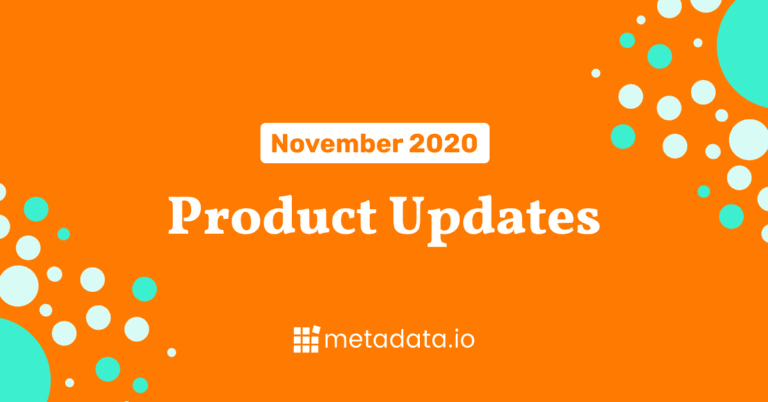How We Automate Paid Social Media Campaigns Using Metadata
This is the first post in our new content series, Meta With Metadata. We’re giving you an inside look at how our Marketing team uses our own product to automate paid campaigns and drive more revenue.
What do Bigfoot, aliens, and stress-free B2B marketers have in common?
They don’t exist. If anyone tells you they’ve seen a B2B marketer who isn’t in a constant state of panic, they’re lying.

The life of a B2B marketer isn’t easy, especially in a down economy when every dollar needs to go the extra mile—or ten.
I spend a good chunk of my day asking myself questions like:
- When should I launch our next campaign, and on which channels?
- How many experiments do I need to run?
- Did my audiences work last time, or should I build new ones?
But it’s necessary mayhem; diversifying our channels is key to making sure our demand generation engine has what it takes to power us through 2023 so we can hit our revenue targets.
Why native ad channels fall short for us
I’ve run a lot of campaigns with native ad channels. I know you have, too. Meta wouldn’t be the ad-dollar magnet it is today if that wasn’t the case.
While these channels thrived during the early days of paid advertising, they lack the flexibility and transparency B2B marketers need to stretch their budgets further.
I feel confident saying native ad channels will only get you halfway to your pipeline and revenue goals.
A black box of doom
Native ad channels are broken, but not because they don’t work. They do.
They’re broken because they make B2B marketers structure their campaigns in a way that goes against every page of the modern B2B marketing playbook.
In the example below, that’s $100 a day, which means the channels will try to spend that amount, and when they do, the campaign goes dark until the next day.

Your campaigns then branch into audiences (the people who’ll see your ads) and creative (the ads). I won’t dig too deep into the inner workings, but I’ll say this: This structure is the reason why native ad channels are really budget graveyards.
Beneath this faulty campaign structure are some less-than-ideal intricacies that strip even more value.
We’re going to talk about one of them: The launch process.
Build, build…and build again
I’ll be the first to admit launching campaigns natively isn’t rocket science. Sure, there’s a learning curve, but once you wrap your head around how it works, setup becomes second nature.
So, if complexity isn’t at the core of B2B marketers’ gripe with native ad channels, what is? The manual, time-consuming, and painstakingly repetitive tasks required to launch campaigns.
Think about everything that goes into a campaign:
- Goals
- Audiences
- Creative
- Experiments
- Measurement
- Optimization
Some of these things take shape outside native ad channels. For example, your goals and experimentation strategy will come together in meetings and Zoom calls.
You assemble the rest of these things, however, inside native ad channels—and boy, do they require a lot of button pushing.
In native, you’ll be spending your time:
- Building individual audiences with siloed targeting criteria
- Creating campaign groups with multiple ad variations
- Manually uploading creative variations
- Configuring experiments with only your spreadsheet as a guide
The list goes on. And these are only some of the steps that come before you launch a campaign. There’s an even longer list of pitfalls that crushes performance after the fact.
These manual, repetitive, albeit necessary tasks swallow your limited bandwidth and rob time you could spend on tasks like planning your experiments or working with your design team to come up with head-turning creativity.
Here’s where the true pitfall comes into play.
Once you get your ducks in a row inside one channel, you have to do the same in every other channel you want to launch the campaign on. This wastes even more time and opens the door to human error.
Keep in mind, you haven’t even launched yet. Once a campaign is live, your team has to manage these campaigns in siloes, manually optimize everything, and report on what some would call “vanity” metrics. Like Cost-per-Click, Leads, and Cost-per-Lead.
I think back to my days before Metadata and I cringe at the performance and efficiency gains I left on the table simply because I had to do everything manually. That can’t happen in 2023.
How’s launching campaigns using Metadata any different?
If native ad channels are a “black box,” Metadata is the sledgehammer that breaks it open.
With Metadata, you build your audiences in one place (see below) using 10+ data sources, with first and third-party data. You can even tap into intent data without the manual and repetitive work.
Good luck doing that in native ad channels.
These audiences are then prepped and ready to go live across channels, allowing you to move beyond their individual and limited targeting criteria.
Why recreate the wheel if you just built one? Metadata makes sure you never have to.
Instead of building your audiences in siloes, Metadata enables you to build everything in one place, and that’s efficiency at its finest. Because you’re tapping into the same data sources —not the individual ones offered in each channel—you’re also making sure the same people see your ads across channels, and that’s a superpower.
At Metadata, we believe in a 1-1-1 approach when running paid ads: audiences, ads, and offers.
This testing methodology lets you have more control over every variable so you can see what’s working and make the right moves in the best interest of your budget (and the watchful eyes of the leadership team).
How we automate paid social media campaigns using Metadata
We eat our own dog food and drink our own champagne (after hours, of course). Just about every dollar in our demand gen budget runs through Metadata.
Why? Because it makes launching campaigns painless and gives us time back so we can focus on the big things like strategy, creativity and driving revenue.
Here’s how we automate paid social media campaigns in four steps:
1. We do the heavy lifting up-front with rock solid briefs
Every campaign starts with a brief. No exceptions.
Campaign briefs summarize the foundational elements of your campaigns. They help you, the B2B marketer, organize your thoughts but also give other internal teams the TL;DR of what you’re trying to accomplish.
Here’s what we typically include:
- Goals
- Budget
- Audiences
- Channels
- Creatives
- Offers
2. We build accurate audiences—once
Once we have a solid brief, it’s time to create audiences.
If we were launching campaigns in native ad channels, we’d do this inside each “room”—and then we’d have to replicate it for each channel.
It’s a manual process, and worse, it’s fragmented. Each channel has its own targeting criteria and it’s impossible to know if you’re actually reaching the same people across them.
The model is broken, but that’s ok because we build our audiences using MetaMatch, our patented personal-to-corporate identity graph that matches personal emails business profiles.
From a launch standpoint, the value of MetaMatch comes by removing the need to create (and recreate) audiences across channels. With MetaMatch, we do it once and walk away knowing we’re getting our ads in front of the same people, regardless of whether they see them on Facebook, Instagram, LinkedIn, or Google.
3. We choreograph the paid social media dance in one fell swoop
With our brief and audiences, we’re ready to outline what we want the campaign to look like. That means setting our budget, picking channels, building experiments, and creating the ads—and then putting it all into Metadata.
Budget
Setting our budgets for upcoming campaigns starts by looking at the past. What does our current pipeline look like, and which channels created the most qualified opportunities?
With a high-level understanding of benchmarks and performance, I can start thinking about where this budget should go.
From there, I look at historical conversion rates between every funnel stage to figure out how many leads, opportunities, meetings, and everything else we need to hit our goal.
I then project our cost per lead (CPL) across channels and put it into our spreadsheet to come up with the budget for each group.
These numbers then go into Metadata.
Experiments
Experiments are neglected by many B2B marketers for so many different excuses reasons. The biggest one being lack of time. At Metadata, we embrace them with open arms.
We use experiments to test audiences, messaging, creative, and offers across our paid social media channels. Although they can take many forms, we build all our experiments on a foundation held by three pillars: a hypothesis, a baseline, and a goal.
Here are some examples:
- Which messaging resonates with our audiences?
- Can Facebook be an effective channel?
- Do ads with people perform better than those that don’t?
- Do longer or shorter headlines convert more people?
- Do webinar ads perform better on LinkedIn or Facebook?
- Does capitalizing certain words make a difference?
I would bet the farm you can’t even start to ask these questions (or find answers) if you’re knee-deep in native channels all day.
We look at performance in the context of our goal and double down on what’s generating the best outcomes. It’s data-driven marketing at its finest.

Launch, automate, and monitor (then smile)
After some QA to make sure everything’s in tip-top shape, we launch. That’s it.

From there, Metadata optimizes the campaign and automatically allocates the remaining budget based on what’s driving pipeline and revenue—and it does it all without the mind numbing tasks paid social media advertising at scale creates.
It’s that easy, and the results speak for themselves.
Work smarter, not harder
Sometimes in life the hard way is a time-tested tradition. Sometimes it’s just hard for no reason.
In the context of paid advertising:
- The hard way: Native ad channels
- The better way: Metadata
When it comes to your paid advertising strategy, Metadata always wins.
It’s 2023 and the pesky “do-more-with-less” narrative is still lingering in our Slack and inbox. While your boss is asking for the world, you should be asking yourself what you can do to generate the same output with fewer resources.
The obvious answer is time. A few hours here and there would work wonders. Unfortunately, daylight saving time just made matters worse.
The alternative is to find inefficient pockets of your day and streamline them. If you’re launching your campaigns in the native ad channels, you’re dealing with the epitome of inefficiency and time suck.



